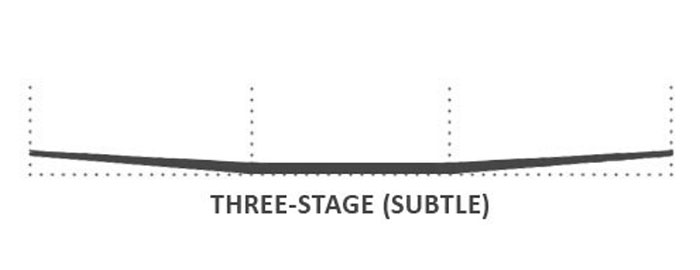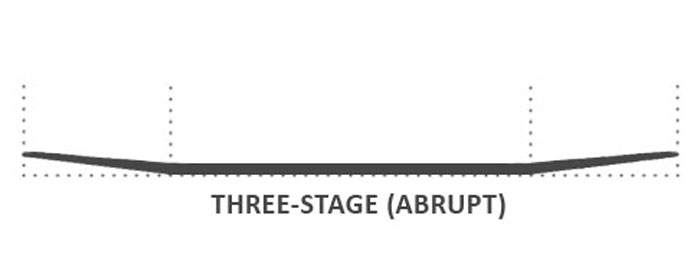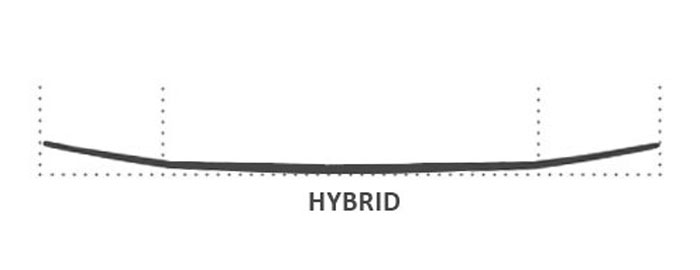
-

Just like a snowboard or surfboard, the surface area on the bottom of a wakeboard determines how much weight it can keep afloat (at an optimal speed). If you choose a wakeboard that’s too small for your weight, it’ll be harder to stand up and control the board once you get moving. On the other hand, if the board is too large, it may be harder to maneuver and perform tricks.
Most wakeboard manufacturers include a recommended weight range for each model and size they offer, so there is no “universal” chart. However, the following sizing chart (based on sizing recommendations for Hyperlite) can serve as a good starting point. Just be aware that other brands may have different size and weight ranges, so it’s a good idea to check for brand-specific weight ranges first.
Board Length Rider Weight 110 cm Up to 95 lb. 120 cm Up to 105 lb. 125 cm Up to 130 lb. 135 cm 140+ lb 140 cm 160+lb 145 cm 170+lb -
In order to provide flotation, modern wakeboards have a slightly concave shape, called “rocker.” This shape allows the board to carve along the surface of the water and launch into the air off a boat’s wake. There are several different types of wakeboard rocker, and each has a specific advantage.
Continuous Rocker
This board shape forms a continuous curve from tip to tail, which helps provide smooth transitions and also produces the least amount of drag compared to other rocker types. This shape is ideal for riders who like to carve and perform surface tricks. It’s also the best option for beginners.

Three-Stage Rocker
Instead of one continuous curve, this style features three distinct surfaces, called stages. The profile of a three-stage board looks similar to a dinner plate, with a flat surface on the bottom and noticeably upswept tip and tail sections. Wakeboards with three-stage rocker produce more “pop” when launching off wakes, but they also create more drag, which can make them slightly more challenging to ride. There are two main variations of three-stage rocker:
Subtle Three-Stage Rocker has a longer, more gradual upsweep from the middle of the board to the tip and tail. Some brands refer to this as “gradual” or “mellow” three-stage rocker. This board shape has a shorter flat section in the middle and offers a moderate boost in pop, making it ideal for beginner and intermediate riders who want to start learning tricks.

Abrupt Three-Stage Rocker has a more prominent upsweep at the tip and tail, with a longer flat section in the middle. Some brands refer to this as “aggressive” three-stage rocker. Abrupt rocker produces maximum pop off the wake, but also produces more drag compared to subtle rocker. This style is ideal for intermediate and advanced freestyle riders who want to hit big airs, grabs and spins.

Hybrid Rocker
This style is essentially a combination of continuous and three-stage rocker. Some hybrid boards have a subtle curve in the midsection with a moderately upswept nose and tail section. In other words, the shape combines two different curves into one hybrid shape, with three or more individual stages. Hybrid shapes are ideal for riders seeking maximum versatility.

-
Aside from rocker, wakeboards may include several other features that can enhance handling and performance on the water.
Wakeboard Channels, Spines and Rails
Hull contours, channels, spines and special rails in the bottom of a wakeboard are designed to enhance handling, improve edge grip for carving, soften landings or add stability during grinds. Many brands have proprietary names for these features.
Fins
Similar to the fins on the bottom of a surfboard, wakeboard fins are designed to provide better stability and tracking in the water. Some wakeboards include removable fins or fin extensions, which allow riders to customize the ride according to their preference. Generally, smaller fins are better for freestyle riding and larger fins are better for carving.
Stringers
Designed to provide torsional stability, stringers are thin strips of flexible material, usually wood, that are built into the core during construction.
Glass Layup
Layers of fiberglass mesh are often added when building a wakeboard or wakeskate core to add structural integrity. This feature is sometimes called glass layup, or it may have a proprietary name, such as Triax glass.
Base
A wakeboard base is designed to provide a smooth, durable surface on the bottom of the board. Bases are typically made of thermoplastic or another material that is sintered or extruded over the core.
-

Bindings and boards are typically sold separately, although some brands do offer package deals that include both. Nearly all bindings and boards are interchangeable, so you don’t have to buy both from the same brand. There are two primary types of bindings available:
One-Piece Wakeboard Bindings
As the most widely available style, one-piece wakeboard bindings combine a boot and binding into a single unit, which bolts onto your board with metal screws. Most allow you to fine tune your stance angle with minor adjustments. These bindings come in two variations: open-toe and closed-toe. The choice mostly boils down to personal preference, although the open-toe vs. closed-toe debate has been ongoing in the wakeboarding community for years. You can read more about it at WakeWorld.com.
- Open-Toe Bindings may be a little easier to get in and out of when you’re in the water. A good choice for most beginners.
- Closed-Toe Bindings may offer slightly more control and prevent “toe lift,” which some believe affects response and boardfeel.
Two-Piece Wakeboard Bindings
Instead of combining the boot and binding into a single unit, two-piece wakeboard bindings include separate boots and bindings, very similar to the boots and bindings used for snowboarding. This style of binding is generally designed for advanced riders who are looking for maximum control and customization.
-

Just as wakeboarding is an offshoot of snowboarding and waterskiing, the sport of wakeskating is an offshoot of skateboarding and wakeboarding. Instead of bindings, modern wakeskates feature a top layer of grip tape, molded EVA foam or a combination of both. This grip-enhancing surface allows the rider to control the board and perform tricks like pop shuvits, kickflips and grinds. Most wakeskaters wear skate shoes or sneakers with rubber soles to provide extra grip and protect their feet. Learning to wakeskate is generally considered more challenging than learning how to wakeboard, although people with skateboarding experience will have a slight advantage.
Wakeskate Sizing
As with wakeboards, most wakeskate manufacturers include a recommended weight range for each model and size. There is no “universal” chart. Most wakeskates fall within a 39” to 46” length range.
-

The most important and absolutely essential piece of protective equipment for both wakeboarding and wakeskating is a USCG-approved PFD life vest. For more info on choosing, fitting and taking care of your life vest, check out our PFD Guide. If you plan on learning tricks, especially grinding rails or hitting jumps, it’s also a good idea to wear a skate helmet. For comfort on the water, it’s hard to top a pair of boardshorts and a quick-drying rash guard.
Well, that about wraps up our wakeboarding guide. We hope you found the information useful. Thanks for reading. Stay safe, and have fun out there!